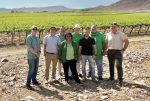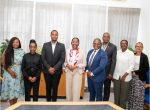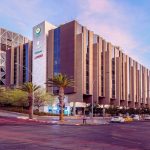In a landmark decision poised to reshape Namibia’s mining landscape, Bezant Resources PLC has secured the golden ticket it needs to unlock the untapped riches of its Hope & Gorob copper-gold project. The Namibian Ministry of Environment and Tourism granted the company a critical Environmental Clearance Certificate (ECC), clearing the final regulatory hurdle to activate Mining License No. 246—a pivotal milestone that propels the project from blueprint to reality. Nestled in the arid expanses of Namibia’s Erongo Region, a stone’s throw from the Atlantic coast, Hope & Gorob now stands at the heart of a narrative blending economic ambition, environmental stewardship, and the promise of transformative growth.
The ECC, formally numbered 240130002744 and issued under Section 32 of Namibia’s Environmental Management Act of 2007, caps a rigorous approval process that began in late 2024. Bezant’s journey to this moment started on October 16, when the Ministry of Mines and Energy signaled its intent to grant the mining license, contingent on environmental compliance. By mid-November, Bezant had accepted the license’s terms, binding the company to a framework prioritizing sustainable practices, community engagement, and adherence to Namibia’s vision for responsible resource extraction. The ECC’s approval, now awaiting formal written confirmation, validates the project’s Social and Environmental Impact Assessment (SEIA) and its comprehensive Environmental Management Plan (EMP), which outlines protocols for water conservation, waste management, land rehabilitation, and biodiversity protection.
For Bezant Executive Chairman Colin Bird, the ECC is more than bureaucratic progress—it’s the spark igniting the project’s next phase. “This isn’t just a regulatory win; it’s the foundation for unlocking value for our stakeholders and the Namibian people,” Bird remarked. “We’re now poised to transition from planning to action, with a focus on delivering a mine that balances productivity with planetary care.”
A Project Forged in Partnership
Hope & Gorob’s significance extends beyond its copper-gold deposits. Namibia, a nation synonymous with diamonds and uranium, has long sought to diversify its mining sector, and Bezant’s project aligns seamlessly with this goal. Preliminary estimates suggest the site harbors high-grade ore, though exact figures remain under wraps. Industry analysts, however, note that the project’s proximity to existing infrastructure—including Namibia’s well-developed road networks and the port of Walvis Bay—positions it as a cost-effective venture with streamlined logistics.
The SEIA process, conducted over 18 months, involved extensive consultations with local communities, traditional leaders, and environmental groups. Key concerns centered on water usage in the drought-prone region and the protection of endemic wildlife, such as the critically endangered Hartmann’s mountain zebra. Bezant’s EMP addresses these through innovative solutions: a closed-loop water system to minimize freshwater extraction, artificial wetlands to treat runoff, and partnerships with conservation NGOs to monitor wildlife corridors. “This isn’t just about compliance; it’s about setting a new standard for eco-conscious mining in Africa,” emphasized a Ministry spokesperson.
Economic Winds of Change
With the ECC secured, Bezant’s focus shifts to financing and construction. The company is in advanced talks with European and African development banks to secure $120 million in funding for Phase 1, which targets open-pit mining of near-surface deposits. Engineering teams have already drafted blueprints for processing plants, worker housing, and solar-powered installations aimed at slashing carbon emissions—a nod to Namibia’s ambition to derive 70% of its energy from renewables by 2030.
The project’s economic ripple effects could be profound. Namibia, grappling with a 33% youth unemployment rate, anticipates over 500 jobs during construction, with 300 permanent roles post-commissioning. Skills development programs in mining technology and environmental management are slated to launch alongside operations, fostering a pipeline of local talent. “This project isn’t just digging rocks; it’s planting seeds for a skilled workforce,” said Uazuva Kaumbi, a community leader in Usakos, the nearest town to Hope & Gorob.
Navigating Headwinds
Yet challenges linger. Global copper prices, while buoyed by renewable energy demand, remain volatile, and Bezant faces stiff competition from giants like Rio Tinto and De Beers, who dominate Namibia’s extractive sector. Additionally, logistical hurdles—such as securing specialized equipment amid global supply chain snarls—could delay timelines. Bird, however, remains bullish: “Our lean operational model and strategic partnerships insulate us from market turbulence. We’re built for resilience.”
A Vision Beyond Extraction
Hope & Gorob’s legacy may ultimately hinge on its social footprint. Bezant has pledged 5% of future revenues to community trusts funding education, healthcare, and small-business incubators. Early initiatives include scholarships for geology students at the University of Namibia and a pilot agro-processing cooperative for women farmers near the mine site. “We’re not just taking resources; we’re investing in futures,” Bird asserted.
As the Namibian sun beats down on the Hope & Gorob site, the project embodies a delicate dance between ambition and accountability. For a nation eager to leverage its mineral wealth for inclusive growth, and for a company betting its reputation on sustainable practices, the stakes couldn’t be higher. With shovels set to break ground in early 2025, Bezant’s journey is a litmus test for 21st-century mining—a venture where profit and planet coexist, and where the dust of excavation might just lay the groundwork for a brighter tomorrow.










